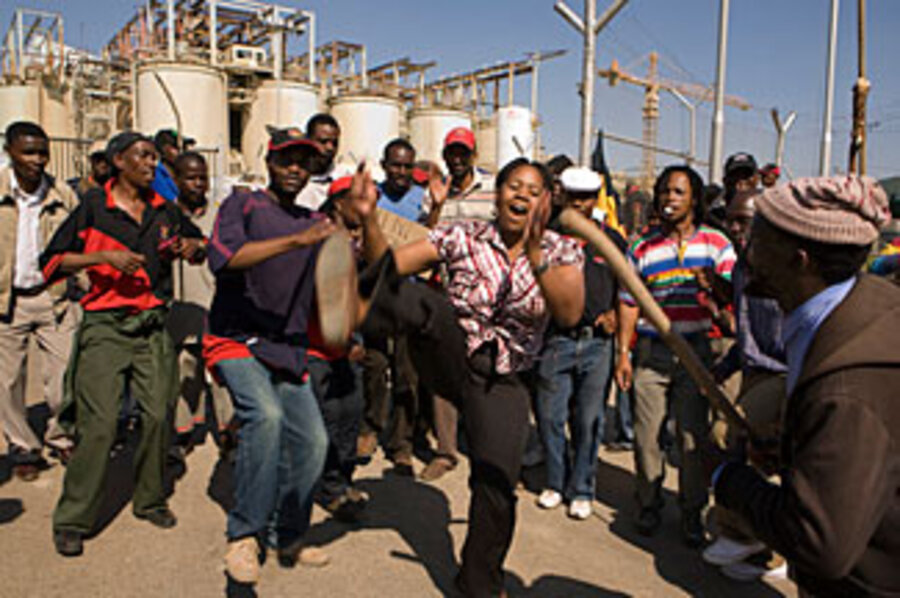Gold tops $1,000. But South African miners not benefitting.
| Johannesburg
The gold miners gather in front of the old Crown Gold Mines and begin a peculiarly South African form of protest. They dance, hoot horns, wave knob-kerry sticks, and generally appear to be having a fabulous time.
But the joyous mood hides a serious problem. These workers are striking for a 13 percent salary increase. Food prices here are skyrocketing, and gold prices are hovering at more than $1,000 an ounce.
"[DRD Gold] is paying us peanuts," says Juliet Sibanyoni, a plant operator, "but we are not monkeys. They should not pay us peanuts."
But DRD Gold, which owns Crown Mines and two other facilities, says record gold prices don't make record profits. Even though gold prices are high globally, the value of the US dollar is weak. By the time DRD Gold converts its dollars into the strong South African rand, the company says that it sees almost no profit.
For an industry that once defined South Africa's gold-rush economy, these are worrying times, and the growing bumptiousness of South Africa's unions is a sign of more trouble ahead.
"I don't want to suggest that this is a bad time for the gold mining industry, but it's not a euphoric situation either," says Azar Jammine, director of Econometrix, an economic analysis company in Johannesburg. The problem is that South African mining companies are hit hard by two economic trends: One, there has been 11 percent inflation, which means that the cost of tools and services have increased for the mining company's daily operations. Second, the falling value of the US dollar – which is the currency that all gold is bought and sold in world wide – means that mining companies here see almost no benefit from higher prices.
30 percent increase in gold prices
Over the past year, the price of gold has risen from $750 an ounce to more than $1,000 an ounce, but at the same time, the value of the dollar has dropped from 10 rand to 7.5 rand to the dollar. This means that in rand terms, the value of gold has not increased at all.
On top of that, South African mines are more expensive to operate than elsewhere.
"In South Africa, most of the gold is at very deep levels – up to 3 miles deep – where in other countries, including your own, many of the mines are much shallower," says Mr. Jammine. "The cost of producing our gold is much higher than it is abroad, so this is another reason why mining companies need to contain their costs."
Such arguments have little sway among the gold miners, many of whom work with toxic chemicals to leach out traces of gold from the mine tailings – the leftover rock and soil that once contained gold deposits – at DRD Gold's facilities here in Johannesburg and other parts of South Africa.
Negotiations between DRD Gold and the National Union of Mineworkers have broken down, and DRD efforts to have the current strike declared illegal have failed in court. The impasse largely revolves around wages. An entry level mineworker working above ground earns 4,500 rand (about $616) per month, which is roughly what a South African school teacher earns. The mineworkers union is requesting a 13 percent pay increase, while DRD is offering 6 percent.
"We understand that there is a recession, but they [management] are not feeling the recession. We are the ones feeling the recession," says Johannes Matani, shop steward for the local branch of the National Union of Mineworkers at the Crown mines. "DRD is pleading poverty, but we believe they are telling a lie."
One striker moves into the crowd to show off a handmade sign that reads, in Zulu, "We want 13 percent. Swine flu is better than 6 percent."
Strikes could result in further layoffs
DRD spokesman James Duncan says the current strikes "make a bad situation worse." As it is, deep earth tremors have caused serious damage at DRD's operations at the deep-mining operation at Blyvoor, where the operation has been shut down since June for an estimated 6 months of repairs. In addition, DRD had already begun to study the size of its workforce and looking into layoffs. The longer the strike goes on, Mr. Duncan says, the greater the losses will be for DRD, and the more workers DRD may have to lay off.
In the gold industry, "you share the pain and you share the upside as well," says Duncan. In addition to the base salary that workers earn, DRD Gold also pays up to 8.5 percent when the price of gold increases in rand terms. But given the strange strength of the rand, and the falling strength of the dollar, there can be no talk of sharing the wealth, Duncan says. These are times of pain.
"The only thing you can do is work harder and work smarter, and who wants to hear that?" says Duncan. "I don't either, but that's the simple truth."





